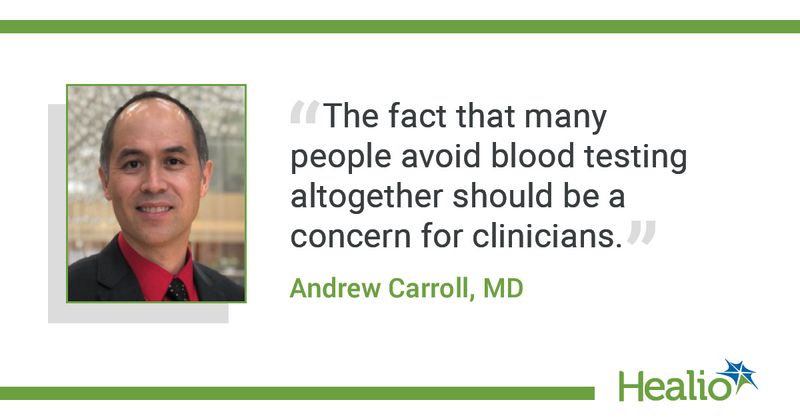Blood
Examining the blood collection experience
August 25, 2023
4 min read
Blood draws do not need to be unpleasant
Modern blood testing is the foundation of clinical screening and decision-making. Timely disease diagnosis, prevention and chronic care management depend on accurate diagnostic testing.
More than 7 billion clinical lab tests are performed in the United States each year, providing critical data for a relatively small expenditure, according to the American Clinical Laboratory Association.
Venipuncture is an age-old practice that uses a needle to safely draw blood from a vein and obtain high-quality samples. By its very nature, the process is an invasive one. Although venipuncture is the most common method used for blood collection, it is hardly routine. Just ask a phlebotomist. Many patients experience pain, discomfort and bruising around the injection site. Seeing needles triggers a vasovagal response in some people. It’s not uncommon for blood draws to require more than one needle stick.
Although these may seem like minor inconveniences, they raise the question: Does such an essential practice as blood testing have to be unpleasant?
The impact of difficult venous access
Venipuncture is expected to be performed in a single attempt. Phlebotomists hope for distinctly visible and palpable veins, making it easy to select an appropriate vein for a blood draw. But not everyone is a good candidate for venipuncture. It is especially challenging for people with difficult venous access and needle phobia.
Difficult venous access, or DVA, refers to a condition in which a health care provider experiences difficulty in locating and accessing a patient’s veins for medical purposes, such as drawing blood, administering medications or fluids or performing diagnostic procedures. The condition affects a wide swath of people, from children to older adults. Studies have shown that the prevalence of DVA in complex patients is as high as 59%.
In some cases, DVA is due to anatomical factors, such as small or fragile veins. Studies have reported that women are more prone to DVA than men. Other individual risk factors that may contribute to DVA include dehydration, obesity, IV drug use and health conditions that cause the deterioration and hardening of veins.
Blood collection is a source of anxiety for others as well. Consumer perceptions about blood collection are not widely studied, but one survey from 2012 provided insights into the patient experience. Of the 200 patients polled, more than three out of four reported that they had difficulty with the blood draw. Within that group, 95% said at least two needle sticks were required to obtain a blood sample and almost 90% suffered bruising.
With these metrics, it’s not surprising that eight out of 10 patients surveyed say their blood collection experience influences their overall satisfaction with the care they receive.
Understanding needle phobia
Another source of anxiety about venipuncture is fear of needles, also known as trypanophobia. Needle phobia is an overlooked condition, but it has serious health consequences, including avoidance of blood testing and vital vaccines.
Becton, Dickinson and Company (BD), one of the world’s leading medical technology companies known for its blood-collection devices, funded a global survey-based study to learn more about the prevalence of needle phobia and its underlying reasons and impacts. The findings should make clinicians reconsider their approach to people who fear needles.
Of the 2,098 participants enrolled in the study, 63.2% reported experiencing needle phobia. This is more than double the estimated 25% of adults with a fear of needles found by previous studies, according to the CDC.
The BD study also provided some interesting insights into this population. More than half of those with needle fear were women. And to make matters worse, about one-third had a condition that requires frequent injections or blood draws.
The impact of needle phobia on patient care is extensive. Of the participants experiencing needle phobia, 52.2% stated they avoid blood draws. General anxiety (96.1%) and pain (95.5%) were the most common reasons for needle fear.
Despite the negative effects, the study found that participants with a fear of needles didn’t find much sympathy from health care workers. Those who shared their fear with clinicians rated their helpfulness at 4.9 on average, on a scale from 0 (unhelpful) to 10 (extremely helpful). The fact that many people avoid blood testing altogether should be a concern for clinicians, and a “get over it” attitude isn’t helping anyone.
The Theranos effect
All this highlights a true need to make blood testing easier and less invasive. Theranos Inc. promised to change the process by only collecting a few drops of capillary blood from a finger stick, which it said it could use to run lots of tests.
Of course, Theranos and its founder Elizabeth Holmes never delivered. But her big idea — to make diagnostic testing more patient-centered — remains front and center. This became even more apparent during the pandemic, when the marriage of convenience and accuracy mattered a great deal.
These new expectations are fueling innovation across diagnostics. There is increased interest and investment in bringing capillary blood draws as a viable alternative to venipuncture for a broad array of tests. New at-home test kits are rising in popularity and can measure certain aspects of wellness, but results remain largely directional. Blood from finger sticks is commonly used for point-of-care testing, which provides accuracy but offers limited test menus.
Given patient demand and impact on adherence, it’s time to bring less invasive options, a better patient experience and accuracy together as a true alternative to venipuncture. Don’t our patients deserve a choice?

